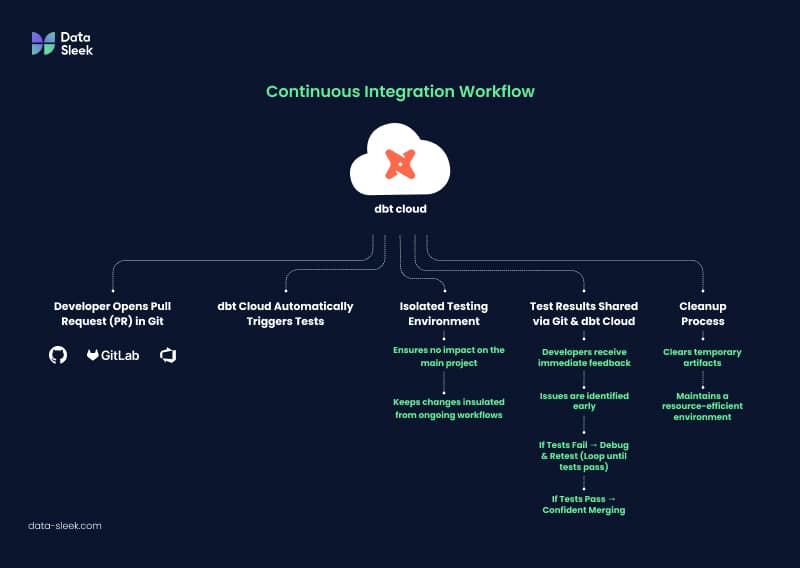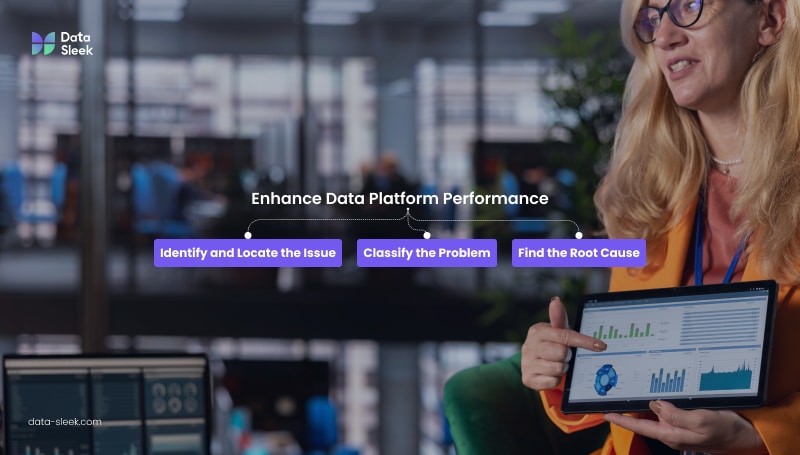
Data teams know the struggle, from mounting compute costs to performance issues and endless testing cycles that can hold your data platform back. So, how can you make your data platform run smoothly with no wasted resources and no delays?
The answer is Dbt Cloud, which helps you simplify your data optimization. With Dbt Cloud IDE’s unique features, like selective processing and continuous integration, you can cut costs, improve productivity, and keep data quality high.
Leveraging these tools, your team can streamline workflows, optimize data transformation processes, and support business goals—all without the typical headaches. In this blog, we’ll learn how you can make your data operations leaner, faster, and more cost-effective.
How Does Dbt Cloud Help in Trimming Your Compute Cost?
We understand that unnecessary data processing can inflate costs and slow down operations. With built-in observability, Dbt Cloud provides specific tools that help prevent unnecessary work, save money, and boost efficiency. Here’s how it works:
- Dbt Defer:
Imagine Dbt Defer as a “replay” button—it reuses prior results from related tasks instead of building everything from scratch. This helps avoid redundant data processing and cuts down costs.
- Model Contracts:
These contracts perform a quick check (preflight check) before running a full data task. If the data structure doesn’t match the expected business logic, the process is halted, saving time and avoiding potential misalignments.
- Unit Tests:
Think of unit tests as logic checks that verify data before starting a full operation. This helps catch and fix issues early, preventing time-consuming errors from reaching further down the pipeline.
By reducing redundant processes, only running necessary data tasks, and leveraging best practices, teams can save both time and money, achieving faster and more cost-effective workflows.
Continuous Integration Workflow for Rapid Testing and Resolution
In data operations, quick and reliable feedback on code changes is essential. This is where Continuous Integration (CI) shines, especially when supported by Dbt Cloud’s seamless integration with Git providers.

Here’s a breakdown of how Dbt Cloud leverages CI to create a smooth and efficient testing workflow:
- Triggered by Pull Request:
As soon as a developer opens a pull request (PR) in Git, Dbt Cloud automatically kicks off tests on the proposed code changes. This immediate feedback helps spot issues early on before they become larger problems.
- Isolated Testing Environment:
Dbt Cloud runs these tests in an isolated, controlled environment, ensuring that tests don’t impact the main project and remain insulated from other changes. This approach maintains the integrity of ongoing workflows.
- Clear Feedback Loop:
The test results are transparently shared via the command line interface and visible through both the Git provider and Dbt Cloud. This feedback loop allows developers to stay in the loop on any issues, speeding up resolution and making for an efficient debugging process.
- Confident Merging:
Once all tests pass, the code can be confidently merged, ensuring that only validated, high-quality code is added to the main branch. This minimizes the risk of introducing bugs or conflicts.
- Cleanup:
It helps in clearing temporary artifacts once the build is complete, keeping the environment clean and resource-efficient.
Requirements for Continuous Integration in Dbt Cloud
Setting up CI with Dbt Cloud is straightforward and only requires three components:
- A Dbt Project
- Git integration (supporting GitHub, GitLab, or Azure DevOps)
- A configured CI job within the Dbt Cloud
CI workflows allow you to test and refine code with confidence, promoting faster development cycles and minimizing the risk of errors sneaking into production. This streamlined process improves collaboration across teams, making the entire data development lifecycle more reliable and efficient.
How to Enhance Data Platform Performance

Dbt Cloud offers tools to help spot and fix performance issues, keeping data processes running smoothly. Here’s a simplified breakdown:
- Identify and Locate the Issue:
Slow processing speeds or failed jobs often indicate a performance problem. Dbt’s tools (Dbt Cloud job logs, Dbt Explorer, query comments) can help track down where the slowdown is happening.
- Classify the Problem:
Once you’ve found the issue, classify it to help determine its cause. Typical issues could include:
- Resource-heavy models
- Complicated data models
- Problems with source data
- Infrastructure limitations
- Find the Root Cause:
Potential causes might be:
- Inefficient SQL logic (e.g., too many complex queries)
- Poor table structure (e.g., overly large data tables)
- Inefficient database settings or outdated documentation
The optimization process follows a cycle of identifying bottlenecks, testing potential fixes, analyzing results, and repeating until performance is optimal. Addressing these can significantly improve data analytics speeds.
Deploying and Monitoring for Cost Efficiency
Carefully monitoring deployments helps ensure both high performance and controlled costs. Here’s how Dbt Cloud assists with this:
- Snowflake: Snowflake costs are based on the engine size (compute power) and data storage.
- BigQuery: Offers options based on how often you need to compute power—either on-demand or with a fixed monthly rate.
By tracking usage and expenses, teams can ensure that their data processes remain within budget while delivering the performance needed.
Make the Most of Dbt Cloud with Data-Sleek’s Expertise
Dbt Cloud provides practical solutions to optimize data platforms through smart compute usage, automated testing, and targeted performance improvements. These tools not only reduce costs but also help maintain the quality and efficiency of data operations.
At Data-Sleek®, our expert data analysts help you leverage Dbt Core and Dbt Cloud’s capabilities to their fullest. By implementing optimized workflows, your team can achieve smoother data pipelines, faster insights, and a stronger alignment between data processes and business objectives.
Contact us today to achieve smoother data operations, fast insights, and seamless API integration for your business.



